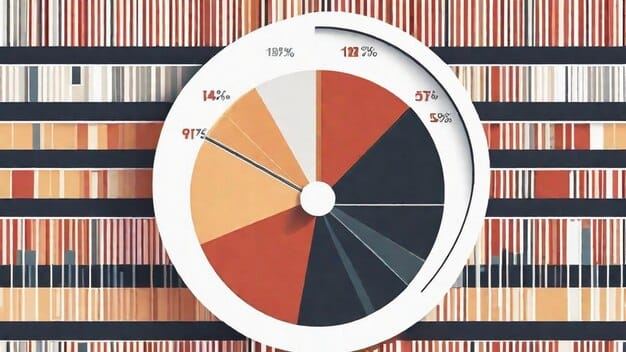Spotting Fake Book Reviews: A Guide for 2025

Book Reviewers’ Secrets: How to Spot a Fake Review (and Why It Matters in 2025) involves critical evaluation of reviews for telltale signs, such as overly generic praise, suspiciously similar language across multiple reviews, lack of specific details about the book, and unusually high or low ratings, safeguarding readers from manipulation.
In the evolving landscape of online book reviews, distinguishing genuine opinions from deceptive endorsements is crucial. Our guide, **Book Reviewers’ Secrets: How to Spot a Fake Review (and Why It Matters in 2025)**, offers actionable insights to identify fabricated feedback and make informed reading choices.
The Rising Tide of Fake Book Reviews
The digital age has revolutionized how we discover and consume books, but it has also opened the floodgates to fake reviews. These deceptive endorsements, often paid for or generated by bots, can significantly skew public perception and impact a book’s success.
Understanding the motivations and tactics behind fake reviews is the first step in protecting yourself from their influence.

Why Are Fake Reviews So Common?
Several factors contribute to the proliferation of fake book reviews, including the desire for authors and publishers to boost sales and visibility, the ease and affordability of purchasing fake reviews, and the lack of effective oversight and enforcement by online platforms.
- Boosting Sales: Positive reviews drive sales, making them a valuable asset for authors and publishers.
- Improving Visibility: Algorithms often prioritize books with high ratings and numerous reviews, increasing their discoverability.
- Undermining Competition: Negative fake reviews can be used to sabotage competing authors and titles.
Ultimately, the promise of financial gain and the relatively low risk of detection make fake reviews a tempting tactic for some.
In conclusion, the increase in fake book reviews is a response to the pressures to succeed in the digital marketplace, where visibility and sales are heavily influenced by online feedback.
Decoding the Anatomy of a Fake Review
Fake reviews often share common characteristics that can help discerning readers identify them. Recognizing these patterns is essential for making informed decisions about what to read.
Let’s explore some of the most telling signs of a fabricated review.
Generic Praise and Vague Language
One of the most common hallmarks of a fake review is the use of overly generic praise and vague language. These reviews often lack specific details about the book’s plot, characters, or themes, relying instead on broad statements of approval.
- Repetitive Adjectives: Frequent use of adjectives like “amazing,” “wonderful,” and “fantastic” without supporting details.
- Lack of Specificity: Absence of concrete examples from the book to illustrate the reviewer’s points.
- Emotional Hyperbole: Exaggerated emotional responses that seem disproportionate to the book’s content.
While genuine readers often express enthusiasm for books they enjoy, they typically do so with more specific and nuanced language.
In conclusion, vague language and repetitive praise are frequently found in fake reviews, lacking the specifics that authentic readers usually provide.
The Suspicious Timing and Review Patterns
Analyzing the timing and patterns of reviews can also reveal potential signs of manipulation. A sudden influx of positive reviews shortly after a book’s release, or suspiciously similar reviews from different accounts, should raise red flags.
These patterns often indicate coordinated efforts to artificially inflate a book’s rating.

Clusters of Reviews
A sudden surge of positive reviews within a short period, particularly around the time of a book’s release, is a common tactic used to create the illusion of widespread acclaim. These clusters of reviews may be generated by bots or paid reviewers.
It’s important to consider the overall trend and distribution of reviews rather than focusing solely on the total number.
In summary, spotting patterns like a sudden rush of reviews or unusual similarities in content helps identify potentially misleading reviews.
Unveiling Reviewer Profiles and Authenticity
Examining the profiles of reviewers can provide valuable clues about their authenticity. A reviewer with a limited history of reviews, or a profile filled with suspiciously similar endorsements, may be engaged in deceptive practices.
Don’t hesitate to investigate the reviewers themselves.
Reviewer History and Activity
A genuine reviewer is likely to have a diverse history of reviews, spanning different genres and authors. Their profile may also include other forms of online activity, such as comments on articles or participation in forums.
Be wary of profiles with limited or non-existent activity beyond posting reviews.
- Diverse Interests: A genuine reviewer typically reads and reviews books across various genres.
- Consistent Activity: Regular contributions and engagement with the online community are signs of authenticity.
- Transparency: A willingness to disclose potential conflicts of interest or biases.
Reviewer profiles offer hints about the credibility of reviews; watch for patterns of activity or the lack thereof.
Spotting a Bias: Understanding Reviewer Motives
Understanding the potential motives behind a review can help you assess its objectivity. While genuine reviewers strive to provide unbiased opinions, some reviewers may have ulterior motives, such as promoting a particular author or undermining a competitor.
Consider whether the reviewer’s perspective might be skewed by personal relationships or financial incentives.
Identifying Potential Conflicts of Interest
Reviewers who have a personal or professional relationship with the author, or who have received compensation for their review, may be unable to provide an unbiased assessment. It’s important to be aware of these potential conflicts of interest when evaluating a review.
Transparency is key in maintaining the integrity of the review process.
Always be mindful of motivations to ensure reviews are providing unbiased perspectives.
The Future of Book Reviews: Authenticity in 2025
As fake reviews become increasingly sophisticated, it’s essential to stay informed about the latest detection techniques and emerging technologies. In 2025, artificial intelligence and machine learning will play a crucial role in identifying and flagging suspicious reviews.
Embrace the future of reviews and the tools that can help.
The Role of Artificial Intelligence
AI-powered algorithms can analyze vast amounts of text data to identify patterns and anomalies that are indicative of fake reviews. These algorithms can also assess the sentiment and emotional tone of reviews, detecting exaggerated or insincere language.
These advances offer hope for a more transparent and trustworthy online environment.
- Sentiment Analysis: AI algorithms can identify the emotional tone of a review, flagging those that are overly positive or negative.
- Pattern Recognition: AI can detect patterns in language and timing that are indicative of fake reviews.
- Network Analysis: AI can analyze the connections between reviewers and authors, identifying potential conflicts of interest.
In conclusion, evolving technologies and the use of AI will play an increasingly significant role in ensuring the legitimacy of online book reviews in the years to come.
| Key Point | Brief Description |
|---|---|
| 🔎 Spotting Vague Praise | Fake reviews often use repetitive, generic adjectives without specific examples from the book. |
| ⏲️ Timing Analysis | Watch out for clusters of positive reviews around the book’s release date, which may indicate manipulation. |
| 🕵️ Reviewer Profiles | Check reviewer history for consistent activity and diverse interests to ensure authenticity. |
| 🤖 The AI Edge | AI-powered tools will help flag suspicious reviews by analyzing sentiment and patterns. |
Frequently Asked Questions
▼
The most common sign is generic praise with vague language. Fake reviews often lack specific details about the book’s plot, characters, or themes, relying instead on broad statements of approval.
▼
Look at the reviewer’s history. A genuine reviewer typically has a diverse range of reviews across different genres and authors. Watch out for profiles with limited or no activity.
▼
Fake reviews can mislead readers, influencing them to purchase books that may not meet their expectations. They undermine trust in the review system, making it harder to find genuinely good books.
▼
AI algorithms will analyze text data to identify patterns indicative of fake reviews. AI will also assess sentiment and emotional tone, detecting exaggerated language, improving the authenticity checks.
▼
Report the review to the platform where it was posted. Most platforms have mechanisms for flagging suspicious content. Your report contributes to maintaining the review’s system integrity.
Conclusion
Protecting yourself from fake book reviews requires a combination of critical thinking, careful observation, and awareness of emerging technologies. By recognizing the signs of deception and utilizing the tools available to you, you can ensure that your reading choices are based on genuine opinions and informed insights, leading to more fulfilling literary experiences.





